Contributed by Patrick Breslin, Santa Fe College, Gainesville, Florida
I tell the following story in my Public Speaking classes:
Once upon a time there was an engineer who worked for a large company. He spent his days in a cubicle happily working at his computer. At midday he would go into the lunchroom and join his fellow employees, and then later return to his tasks. One day, the human resources manager was reviewing the employee files and discovered that this engineer had been with the company for 10 years and had never called in sick once: a decade of perfect attendance! She thought, “This calls for a celebration.” The next day, the engineer walked into the employee lunchroom and was greeted with a standing ovation. Behind the applauding crowd he saw a sign on the wall that said, “Congratulations!” Another sign said, “Ten Years Perfect Attendance!” People were shaking his hand and slapping him on the back. He smiled politely, said “Thank you,” and muttered to himself,
Thereafter, he made it a point to call in sick at least one day every year so that he would never again have perfect attendance, and thus never be subject to the kind of attention he received at the lunchroom celebration. Why? The human resources manager had given him the kind of attention that she would have wanted, by following the Golden Rule: Treat others the way you’d want them to treat you. But that has largely been replaced by the Platinum Rule: Treat others the way they want to be treated.
I tell the above story to my students after they have filled out a version of the Myers-Briggs Type Indicator, or MBTI, that I have designed. I’m certified to administer the official MBTI instrument, but it would cost additional fees for the students, and I choose to not impose that cost on them. The explanations and exercises that I provide help to clarify the results of my own simplified rendition of the assessment in a way that allows the students to understand their own type and that of other people. Moreover, they learn how to customize their communication for specific personality styles.
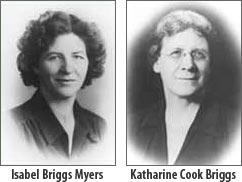 In my lecture I provide a brief historical background of Isabel Briggs Myers and her mother, Katherine Cook Briggs, the creators of this system of analysis. I tell how they crafted their own program of understanding human interaction, and how they then encountered the writings of psychologist Carl Jung, protégé of Sigmund Freud.
In my lecture I provide a brief historical background of Isabel Briggs Myers and her mother, Katherine Cook Briggs, the creators of this system of analysis. I tell how they crafted their own program of understanding human interaction, and how they then encountered the writings of psychologist Carl Jung, protégé of Sigmund Freud.
They adopted Jung’s ideas and added their own to it. At this point I show the students a PowerPoint slide illustrating one of Jung’s mutually related opposite behavioral tendencies, Introversion and Extraversion:
Then I show a slide illustrating the concepts of Sensation and iNtuition.
Onto that slide I overlay Jung’s notion of Thinking versus Feeling:
And I note that Katherine and Isabel embellished the system with an additional idea:
This provides eight personality characteristics:
And I provide slides that show what they look like. For example:
EXTRAVERSION INTROVERSION
I tell my students: “At the end of a long day of school, if you’re slightly tired, and your first desire is to hang out with your friends, then you’re an Extravert. But if you’d rather have some quiet time alone, you’re an Introvert.” I then elaborate on the contents of the following support slide:
From here, I proceed to discuss the next dual concepts:
SENSING INTUITION
I tell the students that Sensing involves perceiving what the senses offer—what is—, while iNtuition entails seeing in the mind’s eye what could be. I say,
“Suppose you’re going to rent an apartment. The apartment manager is showing you around the empty rooms. If you look at what is there and say to yourself, ‘Hmm. Electrical outlets, phone jack, cable jack, AC control, kitchen with microwave, fridge, oven….’ and so on, you are a Sensor. But if you look around and say to yourself, ‘The couch would look great here, the lamp would look great there, the painting would look great up here….,’ then you are an iNtuitive.” Then I discuss the contents of the following support slide:
After this, I introduce the dualism of Thinking versus Feeling.
THINKING FEELING
And I share this hypothetical scenario: Suppose you are the coach of the high school girls’ softball team, and you receive word that your team has been invited to the international playoffs in Tokyo. You think, “Great!” Then you check the budget, and you realize that you only have enough money to send half the team. So what do you do? Do you pick out the best players to send to Tokyo, and leave the others behind with hurt feelings? Or do you say nothing about the invitation to anyone, so that no one’s feelings will be hurt? If you fall into the Thinking category, you might well send the best players. If you are in the Feeling category, you might not say anything about the invitation to anyone. The contents of the following support slide are then discussed:
I add the parenthetical observation that the Thinking/Feeling dichotomy is the only one for which there exists a gender difference. For men, the ratio of Thinkers to Feelers is 75/25. For women, it is the opposite. I discuss the difference in brain structure of women and men to account for this phenomenon. (Any instructor is free to research and elaborate on this at his or her discretion.) I add one more slide image to parodize the gender difference:
From here I move on to the concepts of Perceiving and Judging:
PERCEIVING JUDGING
I ask my students, “What does your closet look like? Is everything organized, or is your stuff all over the place? And what does the trunk of your car look like? Are the cables, jack, and tire iron where they ought to be, or are they just tossed in with old candy bar wrappers?” I then discuss this support slide:
I tell the students that we have now reviewed the 16 personality types of the Myers-Briggs Type Indicator, and that the behavior options for the 16 types are often compared to having a house with 16 rooms.
I say, “Wherever you live, you can go into any room you want and do what you need to, but there’s probably one room that you gravitate back to, one room where you spend most of your time. In the same way, you can engage in many kinds of behavior, but there’s one set of behaviors that feel most comfortable for you. That is your type.”
At this point I tell the students that they will now practice communicating with people who are different than themselves. I ask them to stand up and prepare to move around. I put up this slide:
I tell the “P”s to go to the board at the front left side of the room, and the “J”s to go to the right. Depending on the classroom, either a whiteboard or a chalkboard will be available at the front of the room, and sometimes on the side wall. I show, and read aloud from, this slide:
I tell the students to design their respective posters on the board. I emphasize that the students should create a party that they themselves would enjoy, but they should advertise it so that the other group will show up. I then provide additional instructions to the Perceivers: “Remember, these Judgers party as hearty as you do. They just do it in a more organized manner.” I regard that caveat as necessary, because in my experience the Perceivers will sometimes incorrectly assume that Judgers are stodgy and boring, and will advertise parties for them that feature such things as classical music, backgammon, and discussions of Thoreau, rather than beer pong, bonfires, and a foam machine.
I tell the groups that they have five minutes to complete this, but that is an artificial deadline. Depending on the creative pace of the groups, I sometimes allow up to 10 minutes to complete the task. I then have each group review the contents of their respective “posters,” which typically evokes some laughter among the participants. Poster samples are shown here.
I then regroup the students:
This almost always reveals the inherent gender difference, with males outnumbering females among the Thinkers, and women outnumbering the men among the Feelers. I show the instructional slide:
I tell the participants to think in terms of Valentine’s Day, Hallmark Cards, and Victoria’s Secret, and instruct them to design their posters. After they finish, each group is asked to discuss the contents of its poster. As before, this often results in laughter, and not a small amount of giggling. Here are some sample posters.
I then regroup the students again:
I tell them that the next exercise will not necessary involve writing information on the board, except perhaps for notes. The instructions state:
I tell them that they must jointly craft a message which will be delivered by one member of their team to the other group. I give them five minutes or so, and then ask them to present their results. In most cases they cover all the points quite succinctly. Here are some points that they often cover.
Afterward, we move on to the final pairing of concepts:
Our college in Gainesville, Florida, is located 100 miles north of the subject of this final exercise, so most of the students possess enough familiarity with the topic to carry it off easily:
After they absorb the scope of the assignment, the two groups generally begin by making lists of the characteristics of the various theme parks within Disney World as well as those in Universal, and they almost always include Sea World and the various water parks. After they have worked on this for several minutes, I often have to remind them, “Come up with some music. It doesn’t need to be melodious. Rap or hip-hop would be fine.” That widens the scope of possibilities for them, and several students are usually inspired to download or access Disney ringtones or other suitable music on their phones to incorporate into the structure of their presentation. When their turn comes, each group delivers their radio infomercial, some with surprising artistry and some with amateurish silliness. But they still learn from the exercise and get a laugh out of it. Sample lyrics are shown here: those on the left are sung to the tune of “Time of Your Life” by the band Green Day, and those of the right follow the melody of the Disney tune “It’s a Small World After All.”
To summarize the type behaviors: Outgoing and interactive people—“Extraverts”—become energized by input from multiple sources and individuals, while loners—“Introverts”—revitalize themselves in solitude before venturing into the company of others. “Sensors” like to be given the facts, while” iNtuitives” prefer to contemplate possibilities. “Thinkers” like to receive and deliver messages in a direct manner, while “Feelers” prefer to first give consideration to the emotional impact of messages received and/or sent. “Judgers” prefer factual data provided in an organized manner, while “Perceivers” function best with free flowing and spontaneous information.
When students finish this exercise and return to their seats, I access an online search engine and ask a random student for the four letters of his or her Myers-Briggs type. As I search for those letters, the program auto-fills corollary search options, one of which is “career.” I usually click on the topmost website that appears, PersonalityPage.com. It provides a list of personality descriptors along with examples of the types of careers that such individuals often enter. I then tell the students, “The fact that these careers are shown for your personality type doesn’t mean that you need to do one of these jobs for a living. Every personality type is represented in every profession. But if you were to administer this assessment to people working in these fields, a large percentage of them would have the same type as you.”
My students undergo this game, along with an online assessment, before beginning research for a graded speech on the career they plan to pursue after graduation. (For more information, see the “Speech and Student Career Exploration” page in this blog.) This exercise provides additional research angles, and helps them understand the correlation between personality type and happiness in one’s chosen field.
There is, regrettably, a time constraint in my shorter classes for administering this exercise in its entirety. Some of my classes are 75 minutes long, which is sufficient to encompass all of the components of this activity. Other classes are 50 minutes long, and for those I generally omit the second last exercise, in which the students try to convince Extravert and Introvert high schoolers to enroll at our college. Were I to include it, the class would run too long. Still, the portions of it that time permits seem to convey a sufficient amount of knowledge to the students regarding their personality type and the role it plays in communication.
With regard to communication theory and persuasion, an aspect of the Elaboration Likelihood Model applies here. The ELM comprises two message modalities. One is labeled the Central Route, and involves cognitive processing of a received message in order to prompt a change in the perceiver’s behavior. The second modality is called the Peripheral Route, and consists of the packaging or environment in which a message is conveyed. The first route requires the message receiver to think and ponder in detail, resulting in a behavioral change; the latter, to feel, or rather to be influenced by, something other than thinking. If, for example, a message is sent by an attractive person, or embellished with the inclusion of a box of chocolate or a gift of money, then the message may be more readily accepted and received without substantial deliberation. It is here within the Peripheral Route of the Elaboration Likelihood Model that the Myers-Briggs Type Indicator proposes its effectiveness. If a message is crafted to conform to the preferences of someone’s behavioral style, it will more readily be welcomed, whether or not it also entails the elaborate cognition that the Central Route involves.
At the end of every semester, I poll my students, asking what they liked most about the class and what they liked least. The answer to the latter is almost always “Exams!” though an occasional wise guy will say “Speeches!” But in regard to what they liked the most, they always and without exception mention this Myers-Briggs exercise as the most enjoyable educational activity in the course.
The customized MBTI assessment for this course along with the accompanying PowerPoint slideshow are available upon request for academic institutions. Email patrick.breslin@sfcollege.edu, with the letters MBTI in the subject line; please indicate your academic affiliation. Onsite delivery of a corporate version of the program for business and leadership can also be arranged; email patrick@empowerspeakers.com, and put “Business MBTI” in the subject line.



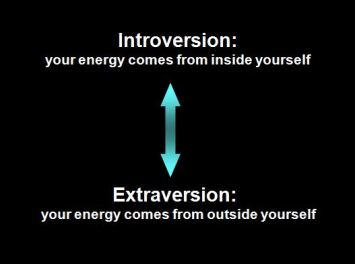


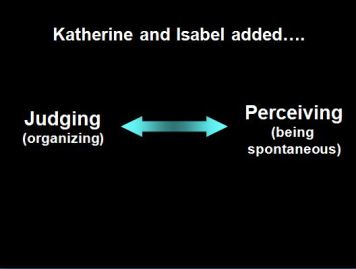
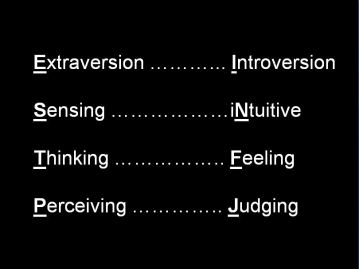


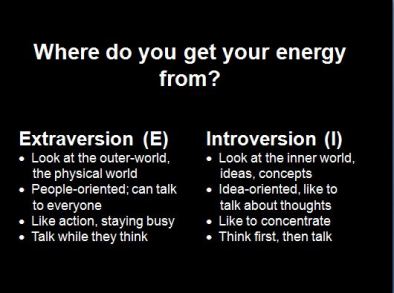












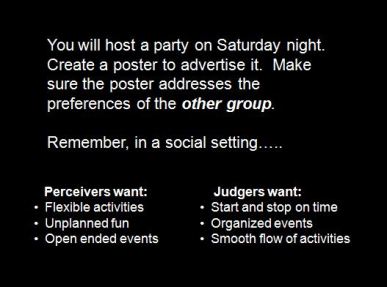
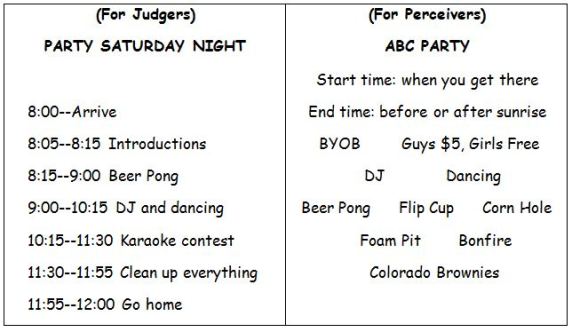
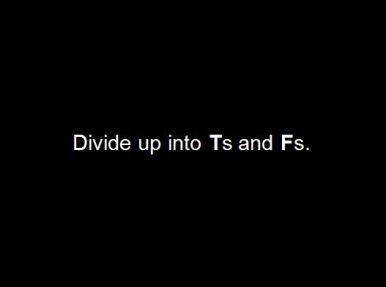
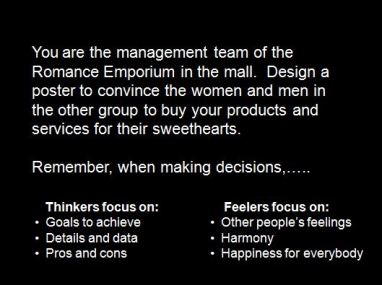


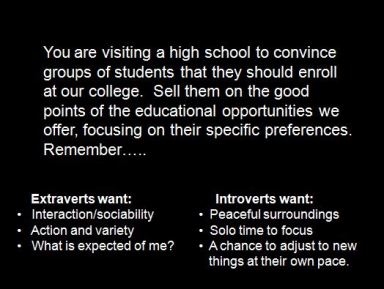

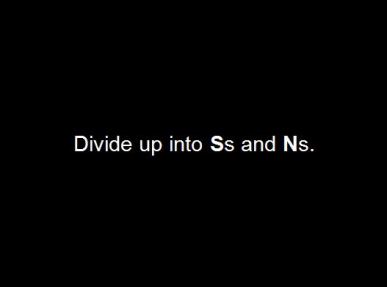
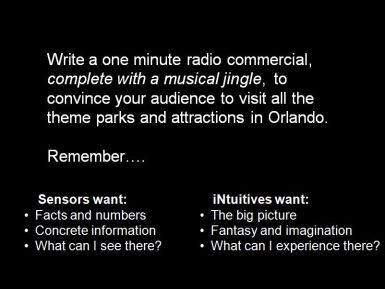
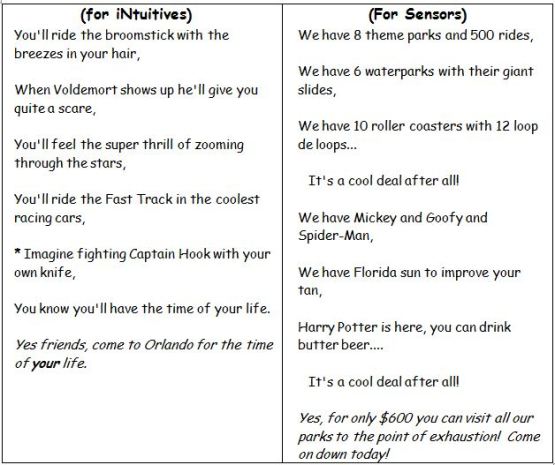
I would like to congratulate you on a truly superb presentation design. I have introduced students to Myer Briggs personality types for years, but must admit to never having used as concise and practical an approach as you have. Thanks for sharing!
LikeLike
This is truly a remarkable class. It has been a while since I’ve seen such a well planned and crafted MBTI class. The examples and activities are on point and I don’t think I have seen this subject being taught in such an immersive and interesting way as this. Thank you very much for sharing this. It truly opened my mind to new ideas and possibilities.
LikeLike
Excellent job of presenting the Myers-Briggs. I can see where your students would cherish this opportunity. I will be requesting a copy for Business Leadership.
LikeLike